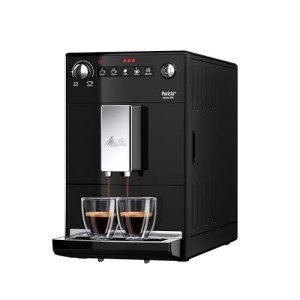Home Use Espresso Machines: A Comprehensive Guide
Espresso machines have actually ended up being a staple in many homes as coffee lovers seek to reproduce café-quality brews in the comfort of their kitchen areas. The increase in appeal has actually led to a diverse market filled with different models, features, and costs. Portable Espresso Machines aims to offer a helpful overview of home use espresso machines, helping readers navigate their options successfully.
Understanding Espresso Machines
Espresso machines work by forcing warm water through finely-ground coffee under high pressure, resulting in a focused coffee drink called espresso. There are numerous kinds of espresso machines classified based on their brewing techniques and level of automation. The most typical types consist of:
- Manual Espresso Machines: These need the user to manage the pressure and water flow, enabling a more hands-on coffee-making experience.
- Semi-Automatic Espresso Machines: These use automatic control over water pressure, while the user by hand grinds and tamps the coffee.
- Automatic Espresso Machines: With the push of a button, these machines immediately manage the circulation of water, making it simpler to brew espresso with constant results.
- Super-Automatic Espresso Machines: These all-in-one machines handle grinding, tampering, developing, and even milk frothing, making them perfect for users searching for benefit.
- Capsule or Pod Machines: These use pre-packaged coffee pods to develop espresso with very little effort, but they limit choice in brewing techniques and tastes.
Table: Comparison of Espresso Machine Types
| Type | Control Level | Ease of Use | Cleaning up Level | Perfect For |
|---|---|---|---|---|
| Manual | User-controlled | Moderate | High | Coffee perfectionists |
| Semi-Automatic | Partial automation | Moderate | Moderate | Home baristas |
| Automatic | Fully automated | Easy | Low | Busy individuals |
| Super-Automatic | Completely automated | Really easy | Very low | Convenience hunters |
| Capsule/Pod | Completely automated | Really easy | Very low | Casual drinkers |
Key Features to Consider
When choosing a home use espresso machine, it's important to think about different features that can considerably impact the quality of espresso and user experience.
- Pressure: Look for machines that offer a minimum of 9 bars of pressure, as this is considered optimal for brewing espresso.
- Boiler Systems: Single vs. dual boiler systems figure out temperature stability and the ability to brew espresso and steam milk simultaneously.
- Grinder: Integrated mills permit newly ground coffee, which improves flavor. Consider machines with adjustable grind settings.
- Milk Frother: For those who delight in cappuccinos and lattes, an integrated steam wand or automatic frother is vital.
- Size and Design: Consider your cooking area area and aesthetic choices. Machines can be found in various sizes, from compact to big setups.
- Cost: Home espresso machines can range from a couple of hundred to a number of thousand dollars, so it's vital to establish a budget before exploring alternatives.
Pros and Cons of Home Use Espresso Machines
| Pros | Cons |
|---|---|
| Benefit of developing coffee in the house | Initial investment can be high |
| Quality of espresso is frequently exceptional | Needs some skill, specifically with manual machines |
| Ability to explore flavors | Upkeep and cleaning can be labor-intensive |
| Can save cash in the long run | Not all machines will suit every coffee preference |
Maintenance and Cleaning Tips
Maintaining an espresso machine is crucial for extending its life and ensuring consistent brew quality. Here are some beneficial ideas:
- Regular Descaling: Minerals from water can develop in the machine. Descale every 1-3 months, depending upon water firmness.
- Daily Cleaning: Rinse portafilters, baskets, and steam wands after each use to avoid coffee oils from building residue.
- Use Filtered Water: This can help in reducing mineral buildup and improve the taste of coffee.
- Change Gaskets and Seals: These elements may wear out over time and needs to be changed to keep pressure and performance.
- Read the Manual: Each machine has specific care guidelines; following these will guarantee durability.
Frequently Asked Questions About Home Use Espresso Machines
Q1: What is the best budget espresso machine?The best budget espresso machine frequently depends on private requirements, however models like the DeLonghi EC155 or the Breville Bambino are popular amongst users for supplying excellent value. Q2: How long do home espresso machines normally last?With Home Espresso Machines , home espresso machines can last anywhere from 5 to 15 years, depending upon the quality of the machine and frequency of use. Q3: Can I make cappuccinos and lattes with any espresso machine?While most espresso machines can make cappuccinos and lattes, having a trustworthy
steam wand or frother is necessary for accomplishing the ideal milk texture.
Q4: Are super-automatic machines worth the investment?For those who prioritize convenience and quick developing, super-automatic machines can be worth the investment, though they might do not have some customizability in brew strength and flavor. Q5: What kinds of coffee beans are best for espresso?While personal choice plays a role, beans identified as" espresso "blends are normally roasted darker, creating rich tastes and a velvety texture when brewed.
Buying a home espresso machine can transform the everyday coffee routine into something special, elevating home brews to café quality. By comprehending the various kinds of machines, key functions to consider, upkeep needs, and weighing the
advantages and disadvantages, customers can make informed choices that fit their specific preferences. As the espresso culture continues to grow, no matter the option, every brew can be a scrumptious experience waiting to be savored.

